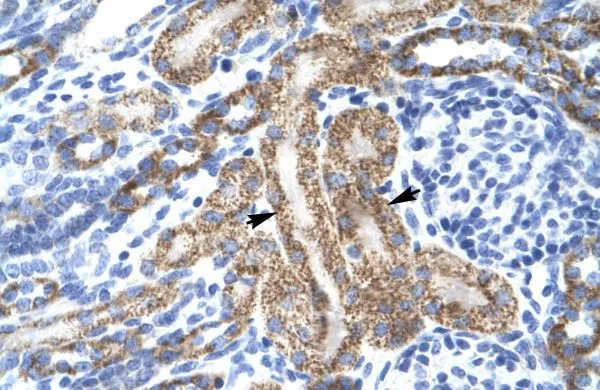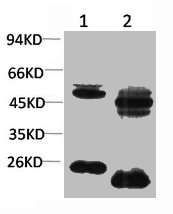KCNA10 Polyclonal Antibody
RD217934A
ApplicationsELISA, ImmunoHistoChemistry
Product group Antibodies
ReactivityHuman, Mouse
TargetKCNA10
Overview
- SupplierReddot Biotech
- Product NameKCNA10 Polyclonal Antibody
- Delivery Days Customer5
- ApplicationsELISA, ImmunoHistoChemistry
- CertificationResearch Use Only
- ClonalityPolyclonal
- Concentration0.66 mg/ml
- ConjugateUnconjugated
- Gene ID3744
- Target nameKCNA10
- Target descriptionpotassium voltage-gated channel subfamily A member 10
- Target synonymsKcn1, Kv1.8, potassium voltage-gated channel subfamily A member 10, cyclic GMP gated potassium channel, potassium channel, voltage gated shaker related subfamily A, member 10, potassium voltage-gated channel, shaker-related subfamily, member 10, voltage-gated potassium channel subunit Kv1.8
- HostRabbit
- IsotypeIgG
- Scientific DescriptionKCNA10 (Potassium Voltage-Gated Channel Subfamily A Member 10) is a Protein Coding gene. Among its related pathways are Potassium Channels and Transmission across Chemical Synapses. GO annotations related to this gene include ion channel activity and intracellular cyclic nucleotide activated cation channel activity. An important paralog of this gene is KCNA4.Potassium channels represent the most complex class of voltage-gated ion channels from both functional and structural standpoints. Their diverse functions include regulating neurotransmitter release, heart rate, insulin secretion, neuronal excitability, epithelial electrolyte transport, smooth muscle contraction, and cell volume. Four sequence-related potassium channel genes - shaker, shaw, shab, and shal - have been identified in Drosophila, and each has been shown to have human homolog(s). This gene encodes a member of the potassium channel, voltage-gated, shaker-related subfamily. This member contains six membrane-spanning domains with a shaker-type repeat in the fourth segment. It is specifically regulated by cGMP and postulated to mediate the effects of substances that increase intracellular cGMP. This gene is intronless, and the gene is clustered with genes KCNA2 and KCNA3 on chromosome 1.
- ReactivityHuman, Mouse
- Storage Instruction-20°C
- UNSPSC12352203



